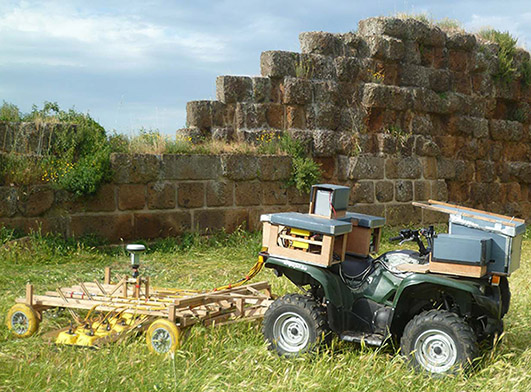(Nederlands: zie onder de figuren)
Lieven Verdonck received the degree of licentiate in archaeology in 2002 (with a dissertation on the Roman rural occupation in the Regione Marche, Italy), at Ghent University. He specialized in archaeological geophysics at the University of Bradford (UK), where he received his MPhil degree in 2008 with a dissertation on the cross-correlation of electrical resistance and ground-penetrating radar (GPR) data as a method for depth estimation in archaeology. Since then, he has carried out geophysical prospections in Belgium (Aalter, Middelburg, Koekelare, Vinkem ...) and the Mediterranean (Italy, Corsica, Greece, Malta, Portugal). In 2012, he finished his PhD at Ghent University, on GPR prospection applied to archaeology. The emphasis was on ultra-dense sampling strategies, and on the development of a multi-antenna GPR-array towed by an ATV (Figure 1). During his FWO post-doctoral fellowship, which started in 2013, he investigated efficient processing strategies tailored to GPR data acquired at Roman sites, and undertook the GPR survey of two complete Roman cities in Central-Italy (Figure 2), within the ‘Beneath the surface of Roman Republican cities’ project in collaboration with the Faculty of Classics of the University of Cambridge. The results of these surveys have been deposited as an open-access archive with the Archaeology Data Service. Currently, his research focuses on the archaeological interpretation of geophysical data (including the application of machine learning and computer vision to the interpretation of large data sets), and on the automation of geophysical data acquisition (by developing an autonomous measurement platform towed by a self-driving ATV).

Figure 1. GPR-array towed by ATV, as it was used at Falerii Novi (Italy) / Figuur 1. Grondradar voorgetrokken door een ATV, zoals gebruikt in Falerii Novi (Italië)

Figure 2. Part of a horizontal GPR slice from Falerii Novi (estimated depth: 75-80 cm) / Figuur 2. Deel van een horizontale doorsnede door de bodem, bekomen door grondradarmetingen (Falerii Novi; geschatte diepte: 75-80 cm)